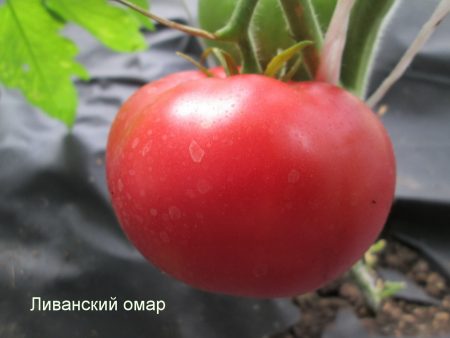
Tomato Omar Lebanese is a rare and popular type of vegetable. Interest in summer residents and gardeners is due to its high productivity and long fruiting. The result is large, tasty fruits.
According to the description of tomato varieties Omar Livansky, as a feature of the vegetable, its mid-ripening and cultivation are distinguished only in a greenhouse. Subject to the rules of care and planting, from one bush of a tomato, you can get over 5 kg of vegetable.
Content
Characteristics and description of tomato Omar Lebanon
Tomato Omar Lebanon belongs to mid-season varieties of giants. The final ripening of fruits occurs 60-65 days after planting seedlings. Particularly intensive growth and development of the vegetable takes place in a warm climate. In such conditions, summer residents and gardeners have the opportunity several times a year to plant tomatoes of this variety.
According to external features, tomato Omar Lebanon is characterized by the following:
- The bush is indeterminate, its height reaches up to 2 m. The leaves are moderate in number, they are no different from traditional tomato ones, have a rich green color. The bushiness of the plant is average.
- Tomatoes of the Omar Lebanon variety have excellent taste and have a certain resistance to certain diseases.
- The fruits of the tomato are large, rounded with a slightly flattened shape. The color is pink, the flesh is red, the peel is smooth and thin. In general, the fruit is fleshy and dense. Almost no seeds. The mass of a tomato can reach from 400 to 1000 g.
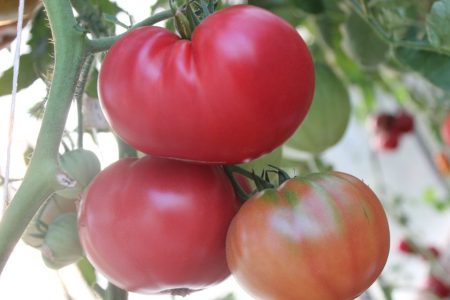
Vegetables of this variety are determined by excellent commercial qualities, they are used for the preparation of many dishes. Especially they go to juices, various salads and fresh consumption. They are not suitable for pickling.
Variety Productivity
Tomato varieties Omar Lebanon refers to high-yielding vegetables. Its fruiting lasts until the autumn and more, if climatic conditions allow. With the proper organization of care and cultivation, the amount of yield from one bush can be from 5 kg.
Advantages and disadvantages
The main advantages of tomato varieties Omar Lebanon are:
- High yield and large fruits.
- The ripening period is 60-65 days from the moment of seedling planting.
- Resistance to certain forms of diseases and pests.
- The plant responds well to quality care, especially watering and fertilizing.
- The fruits of tomato Omar Lebanon are characterized by excellent taste and are used to prepare many dishes.
There are almost no drawbacks. The only thing that summer residents and gardeners emit is high growth, which is why the plant requires constant tying and the use of props, as well as cold intolerance. Therefore, tomatoes are traditionally planted in greenhouses and greenhouses. On the open ground, landing is carried out only if weather conditions permit.
Growing rules
The amount of harvest depends on the correctness of cultivation. Therefore, it is important to adhere to the generally accepted technology, which consists in planting seeds, preparing the soil and planting seedlings in the soil on the street or in the greenhouse.
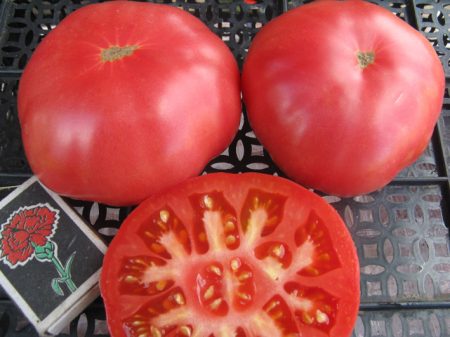
Soil preparation
Experienced summer residents and gardeners know that tomato is a demanding plant and the soil is very important in its growth and development.Therefore, her choice should be taken seriously.
Soil for planting tomato varieties Omar Lebanon should be prepared in the fall. To do this, dig up the earth, if necessary, make separate mineral and organic fertilizers, then dig again.
For planting tomato seeds, a special substrate is prepared, consisting of many components, namely wood ash and sawdust, superphosphate, earth and peat. The resulting mixture is laid out in a special box or individual disposable containers with openings for air.
Growing Tomato Seeds
It is believed that tomato seeds of the Omar Lebanon variety should be sown in late March or early April, so that seedlings grow well and planting falls on the first days of June.
Seeds before planting can be treated with a special drug to stimulate growth or use means that can repel pests and prevent planting death during the growth period.

Growing tomato seeds is carried out in previously prepared containers with a substrate. To do this, the earth is thoroughly moistened and shallow furrows are made. They do not often immerse seeds in them and sprinkle dry earth on top. Lightly watered. The first shoots may appear within 10-12 days after planting.
Transplanting
Planting tomato seedlings is carried out according to traditional technology:
- A plot of land is pre-excavated, small holes are dug, observing an interval of 30 cm between each other and at least 50 cm between rows.
- Wells should be slightly moistened with water.
- Seedlings are immersed in the ground until the roots are hidden. But some summer residents recommend immersing the plant to half its height.
- Top holes sprinkled with dry soil and watered.
Care Rules
The crop quantity also depends on the maintenance of planting. Therefore, timely application of fertilizers, watering, hilling, weeding the beds, as well as timely measures to combat diseases and pests are necessary.
Watering a tomato is carried out daily, water consumption is up to 1 liter per bush. Watering is necessary not from above, but under the root system. In rainy weather, watering is not carried out.
It is also recommended to loosen and spud holes with each moistening, especially during heavy rains, in order to prevent stagnation of moisture and enrich the soil with oxygen.
Tomatoes are fertilized up to 3 times per season. First, it is carried out two weeks after planting seedlings in a greenhouse or open ground, after during the period of intensive flowering of plants and during the formation of fruits, in order to saturate the bush with the necessary vitamins and minerals that are needed for the growth and development of the tomato.
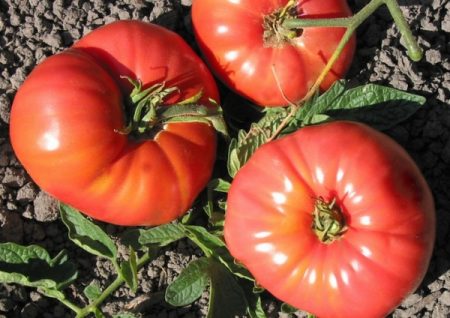
They struggle with diseases and pests by various methods, they use both a folk technique and chemical preparations. But it is best to maintain proper care and for preventive purposes spray plants with special means, avoid growing tomatoes close to potatoes and other vegetables that have common pests. And many summer residents practice watering plants with wood ash, which effectively protects plantings from fungal infections.
Diseases and Pests
Despite the fact that tomato of the Omar Livansky variety has resistance to certain diseases, it nevertheless undergoes some pests and suffers from damage by rot, spotting, mosaic, late blight and other diseases.
Such conditions are dangerous for the plant.They are accompanied by damage to the structure of fruits and leaves. As a result, the latter begin to dry out, turn yellow, often various spots appear and they fall off. In general, the bush quickly fades in the absence of control measures.
Among the common pests, tomatoes are secreted by the bear, whitefly, wireworm, and other insects are less likely to infect this culture.
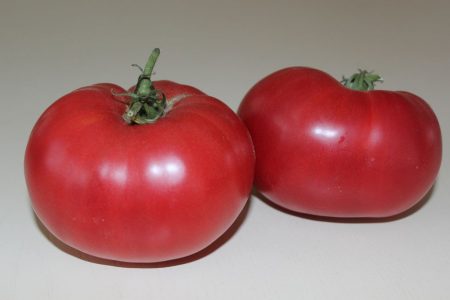
Reviews
Polina, 30 years old
“I liked growing Omar Lebanese tomatoes. I was very surprised by the large fruits, which have the correct shape and are incredibly tasty. It’s not difficult to grow, the only thing is that it’s difficult to care for their high growth.
Veronika, 47 years old
“Tomato Omar Lebanese is my favorite vegetable variety. I grow tomatoes, both in the greenhouse and on the open ground, weather conditions allow me to. The yield is always excellent, the fruits grow large, fleshy, very tasty. They are good in any dishes and fresh. ”
Olesya, 39 years old
“I thought for a long time about the tomato variety Omar Lebanon and planted it on the sample. I thought there would be no harvest, but I gathered a lot of fruits. All of them are large, pink in color, with red fleshy flesh. Since I live in central Russia, cultivation was carried out in a greenhouse. ”




 Low-growing tomatoes, without pinching: 5 of the most delicious varieties
Low-growing tomatoes, without pinching: 5 of the most delicious varieties Why tomato seedlings grow poorly
Why tomato seedlings grow poorly We grow a tomato in a shell
We grow a tomato in a shell Growing tomatoes without watering according to the method of Kazarin
Growing tomatoes without watering according to the method of Kazarin